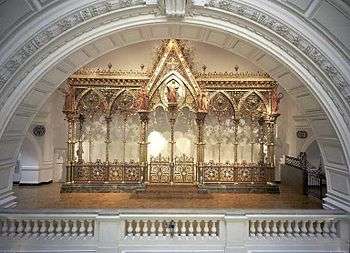Hereford Screen
The Hereford Screen is a great choir screen designed by Sir George Gilbert Scott (1811–1878) and made by Coventry metalworking firm Skidmore & Co. for Hereford Cathedral, England in 1862. It was one of the Gothic Revival works in iron of the nineteenth century. When it was unveiled at the 1862 International Exhibition it was hailed as the "grandest and most triumphant achievement of modern architectural art". Weighing over eight tonnes, the screen is a mixture of wrought and cast iron, brass, copper, semi-precious stones, and mosaics, supporting electroformed statues of Christ and attendant angels. In 1967 the screen was dismantled as it was no longer considered fashionable. The Victoria and Albert Museum acquired the screen in 1984, but it was in very poor condition. In 2001, after a successful campaign to fund the largest conservation project ever undertaken by the Museum, the fully restored metal masterpiece was erected in pride of place, overlooking the main entrance.

Bibliography
- Jackson, Anna (ed.) (2001). V&A: A Hundred Highlights. V&A Publications.CS1 maint: extra text: authors list (link) ISBN 1-85177-365-7
External links
- "The Hereford Screen". Metalwork. Victoria and Albert Museum. Archived from the original on 2008-04-01. Retrieved 2008-08-26.